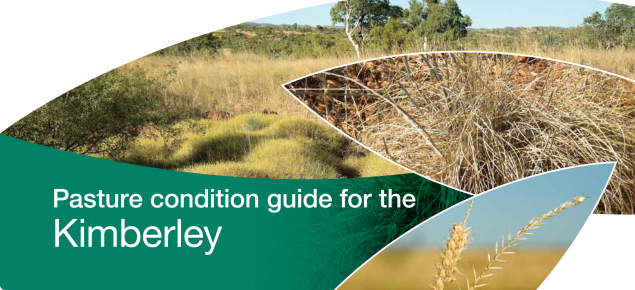Using this guide
We recommend that you read the Introduction to rangeland pastures in the Kimberley web page for a full introduction to the pasture condition guide.
To help you identify your pasture type, use the Key to determine Kimberley pasture types (PDF download).
The pasture guide can be used as a reference for pasture condition assessments and as a training guide for pastoral station staff and others interested in the productivity and maintenance of rangeland plants and pasture communities. By tracking pasture condition, managers can assess the influence of management and set goals for rangeland condition.
Managers can use this guide to assess pasture condition on the listed pasture types in the Kimberley. A pasture type is a distinctive mix of plant species, soil type and landscape position. For example, the Mitchell grass alluvial plain pasture type is a mixture of Mitchell grasses and other species occurring on black soil alluvial plains.
There may be an overlap with the Pilbara pasture types on the western boundary of the Kimberley – see Pasture condition and management guide for the Pilbara if you are managing pastures in that overlap area.
Pasture condition is an important factor affecting animal production and is a useful indicator for the sustainability of production.
Why do we refer to each pasture type as 'pastures'?
We do that because each pasture type has a very broad range of species composition and appearance in different areas. There are enough similarities and common indicator species for the range of pastures to be classified as a type.
Contents of the guide
Read Introduction to rangeland pastures in the Kimberley for an explanation of terms and pasture condition assessment.
Each pasture type described in the guide represents a broad group of similar vegetation and topography. Pastoral values are outlined for each pasture type.
Black soil group
- Mitchell grass upland pastures
- Mitchell grass alluvial plain pastures
- Blue grass alluvial plain pastures
- Ribbon grass alluvial plain pastures
Sandy soil group
Red soil group — spinifex
- Curly spinifex/annual sorghum hill pastures
- Hard spinifex hill pastures
- Hard spinifex plain pastures
- Soft spinifex pastures
- Pindan pastures
Red soil group — not spinifex
- Ribbon grass pastures
- Arid short grass pastures
- Buffel grass pastures
- Black speargrass pastures
- White grass/bundle-bundle pastures
For more information
You can download the full Bulletin, the soil group sections, and the Key to determine Kimberley pasture types.
Acknowledgement
The guide publication was produced with the support of Rangelands NRM.

